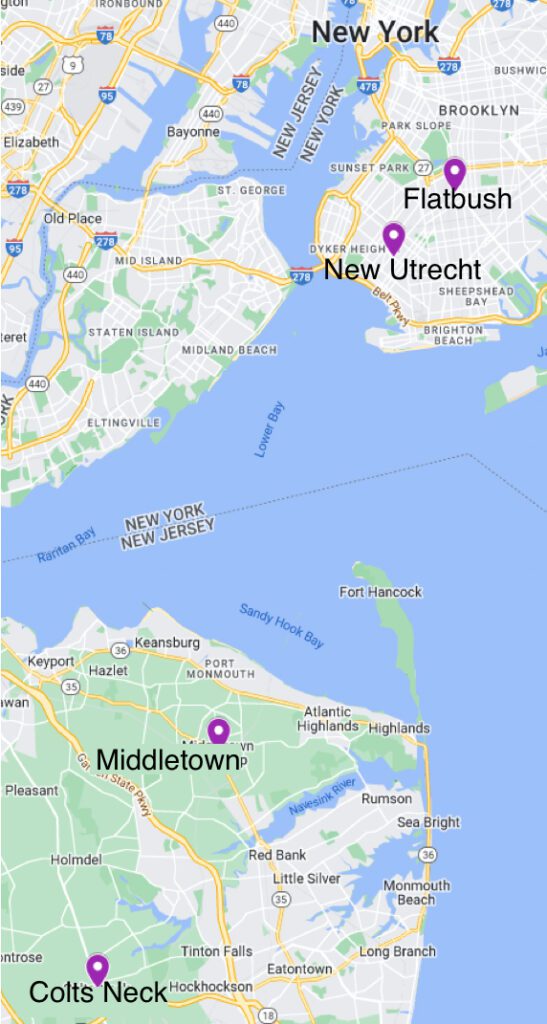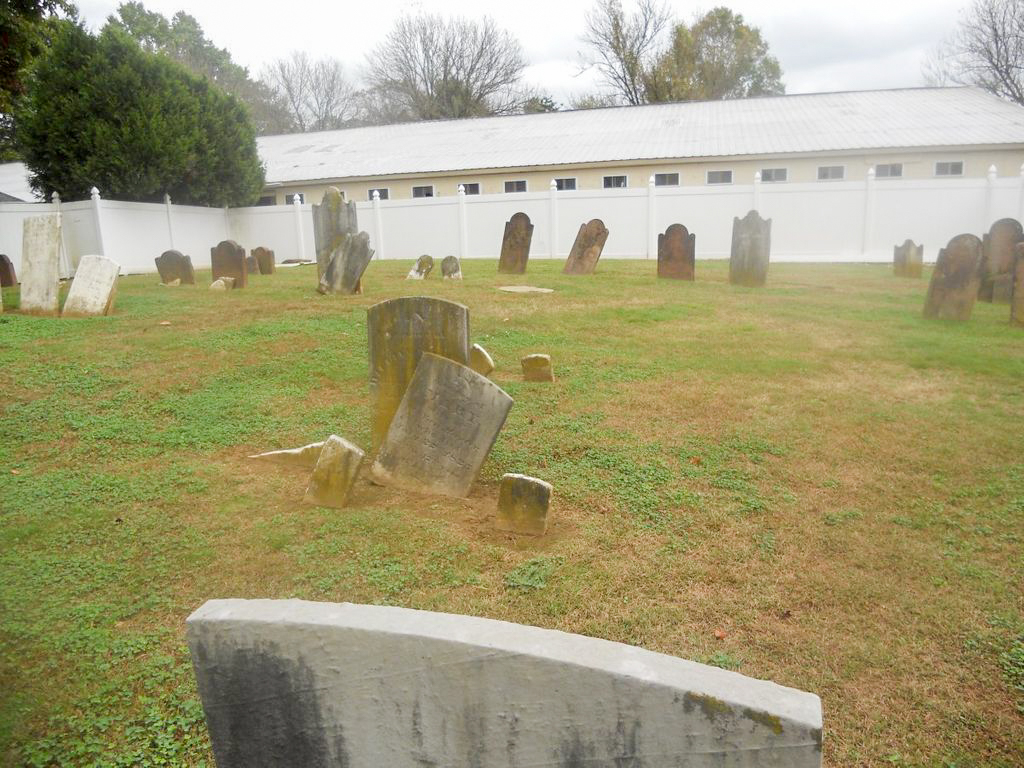Jan Gijsbertse van Meteren Family
Jan Gijsbertse van Meteren was Jan Joosten van Meterens cousin.
Jan Gijsbertse van Meteren, with a variety of spellings, came to America as a widow with his son Krijn Jansen van Meteren in 1663, a year after his cousin Jan Joosten. The first record I could find of them is in New Utrecht, Brooklyn, New York, which is on the western part of Long Island. Krijn later moves his family to Monmouth County, New Jersey.
Table of Contents
Jan Gijsbertse van Meteren
son of Gijsbert Jans van Meteren and Beertge Jansdr.
Born: About 1625 in Zaltbommel, Gelderland, Netherlands.
Died: after 1709 – most likely in Middleton, Monmouth County, New Jersey, although folklore says after he refused to sign the pledge of allegiance to the English in 1687, he returned to his homeland.
Married: Before 1650
1673 – Jan Gysbertse van Meteren selected as magistrate, New Utrecht, Brooklyn, New York.1
“The Governor hath, from the nomination made by the Magistrates of the town of Utrecht, selected Jan Gysbertse van Meteren as Magistrate in the place of Jan Thomassen, now lately deceased.”
New Utrecht, Brooklyn, New York
New Utrecht was the last of six towns established by the Dutch in what is today Brooklyn, New York. [The other five were: Bushwick, Brooklyn, Flatlands and Gravesend.] In 1652, Cornelius Van Werckhoven of Utrecht, Holland, a principal investor in the Dutch West India company, began purchasing land in Brooklyn from the Canarsie and Nyack Indians. The land where the town of New Utrecht was later situated was purchased from the natives for 6 shirts, 2 pairs of shoes, 6 pairs of stockings, 6 adzes, 6 knives, 2 scissors and 6 combs.
After Cornelius died in 1655, Jacques Cortelyou received permission to sell lots of the land to create a town. Under his leadership, nineteen families received grants of fifty acres each. By 1657 New Utrecht was granted status as a village and town and by 1660 eleven houses had been built. The broad Main Street of the village is now 84th Street between 16th and 18th Avenues. In 1661 Governor Peter Stuyvesant granted New Utrecht its own charter. …”
Jan Gijsbertse van Metrn Family
The following is an excerpt from the Early Dutch settlers of Monmouth County, New Jersey (link will take you to a free version), by George C. Beekman, 1901. He also covers Krijns children in more detail, his will and many interesting stories about his descendants that I did not cover here.3
JAN GYSBERTSEN METRN AND HIS FAMILY.
Kreijn, son of Jan Gysbertsen Metrn, as he spelled and wrote his name, was born in Bommel, in the Netherlands March 10, 1650. When a boy of 13 years, or in 1663, he came over with his father to New Amsterdam. Although the father wrote his name as spelled above, yet in old records of Kings county, L.I., and on the records of the First Dutch church of Monmouth and in our county clerk’s office, the name is spelled Van Metra, Van Metee, Van Metteren, and in several other ways.
Jan Gysbertsen, the father, seems to have been better off financially than most of the Holland emigrants. We find him comfortably settled at New Utrecht, L. I., and one of the magistrates of that town in 1673. He was a deacon in the Dutch church in 1683.
It has been thought by some writers that he was on the same family as Jacob VanMeteren of Antwerp, who caused the first complete edition of the Bible to be printed in the English language. This book was printed at Zurich in 1536, and was a great and expensive work. It is thought that the vanMeteren made the translations himself, but employed an English scholar named Miles Coverdale to supervise the printing, in order to guard against errors in the translation. Through Van Meteren the English people had access to the Scriptures in their native tongue. They have, however, never exhibited any gratitude, and gave VanMeteren but scant credit for this costly and beneficial work. [See my posts on Jan Joosten Van Meterens Lineage and Jacobus and Emmanuel Van Meteren].
There is a tradition in the VanMater family, that “Jan Guysbertsen Metrn,” the father, refused to take the oath of allegiance in 1687, and soon after went back to his native land. That he had urged his son very strongly to accompany him but that he refused, on account of his great horror of sea sickness, having suffered intensely on his first voyage over. I think, however, that his great love for blue-eyed, flaxen-haired and pretty Nelly Van Cleaf was stronger than his love for the motherland. He had married at New Utrecht, September 9, 1683, Neeltje (Eleanor), daughter of Jan VanCleef and a resident of the same town.
Jan Van Cleef came from Holland in 1653 and settled at New Utrecht in 1659. His wife was Engeltje, a daughter of Laurens Pietersen. Neeltje, or Nelly, was born at New Utrecht January 1, 1663, the very year her futue husband was tossing on the waters of the Atlantic Ocean. She had a brother Benjamin, baptized in the Dutch church at New Utrecht in November 1683. He married Hendrika VanSutphen and removed to Monmouth County. He and his wife are communicants in the First Dutch church of Monmouth in 1711 and 1719, but her name is spelled on the records as “Hank Sutphin.”
Kreijn VanMater and Neeltje VanCleef, his wife, are named among the first members and organizers of the Dutch church of Monmouth. His name is first entered on the church records as “Krijn Jansen,” and in 1716 when Elder as “Kriin VanMetra.”
He purchased a large tract of land in what are now (1899) Holmdel and Atlantic townships. His first dwelling, a log cabin, was erected on the farm where William Jones now resides in Atlantic township. The old family burying ground is on this farm, and in it many of the past generations of the vanMaters are interred. This farm is but a small part of the original tract.
Kreijn died March 10, 1720, and his wife January 1, 1747. Both are buried side by side in this graveyard, with tombstones giving their names and dates of death. His age is stated about 75 years and her age about 84 years. Nelly, his widow, survived him 27 years and was faithful to his memory. She is said to have been a very handsome and attractive woman, and had several offers of marriage, but none of them would she accept. She never tired of talking about Kreijn and of telling what he said and did, for in all the world there was no such man, she thought. An English visitor on one occasion thoughtlessly remarked in her presence that “Krijn” was a “queer, harsh name.” “Nodings queer,” exclaimed rhe old lady in her broken English, which became more so when she was excited. “Kreijn von goodt name, gooter as effer vas. Just like de singing of de birdts, ven der sprink veather comes, and der coldt vinter go avay.” So she ever dwelt fondly on the husband of her youth until the summons came for her. She died in peace with a smile on her lips, for at last she would meet her Kreijn in the “land of the leal,: never again to part. The old generations of the VanMaters were noted for their faithful attachments to wife, children and kinsmen. They labored and planned, as their wills show, to provide comfortable homes and maintain and guard against misfortune, those near to them by ties of blood.

Middletown, Monmouth County, New Jersey
Middletown was settled by English who migrated from western Long Island and New England, beginning at the 1665 proclamation of the Monmouth Patent by royal governor Richard Nicholls. This grant, issued to 12 Britons, contained several provisions governing settlement. The new settlers were required to secure the land from the local Indians, a population that was, in time, displaced. Additional people were required to settle here in order to foster permanence. Three “villages” were established near-simultaneously, including the short-lived Portland Point located near Atlantic Highlands, Shrewsbury, south of the Navesink River, and the village of Middletown, which was, in a rough geographic sense, in the “middle” of the aforementioned.
Cemeteries from the 17th and 18th centuries are nestled in wooded areas among residential neighborhoods in the Township of Middletown. The fathers, mothers, sons, and daughters interred in these cemeteries are the earliest settlers of our town, and many of our streets are named for their families.
I found their Family cemetery on Find A Grave in Colts Neck, Monmouth County, New Jersey (estimated location). It’s called Van Mater Burying Ground and appears to have 53 souls listed. Among the many Van Maters is Kreijn Janse Van Mater. Jan Gysbertsen was not among them, but Kreijns is the earliest one in 1720, so Jan most likely died before the cemetery was established, or the family stories are true and he returned to his homeland. An interesting side note, his Find A Grave memorial shows him as having another wife named Catherine Sadiogawa. Her Find A Grave memorial didn’t show any details or where she was buried. He was 33 when he married Neeltye, so from a timeline standpoint, it is possible. I didn’t find any record of this marriage, however.

Krijn Van Mater and Neeltye Jansen Van Cleef Children
- Jan Van Mater (1687-?) Died Young
- John Van Mater (1688-1761)
- Ydtje “Ida” Van Mater (1691-1774)
- Gysbert “Gilbert” Van Mater (1694-1773)
- Engeltje “Angelina” Van Mater (1696-1760)
- Benjamin Van Mater (1702-1775)
- Cornelia Van Mater (1704-?)
- Syrenus “Cyrenius” Van Mater (1706-1787)
- Joseph Van Mater (1709-1792)
Citations:
- Colonial History of the State of New York, procured in Holland, England and France, by John Romeyn Brodhead, Esq., edited by E.B. O’Callaghan, M.D., LL.D., Vol II, page 659. Viewed online at https://archive.org/details/documentsrelativ03newy/page/659/mode/2up?view=theater&q=meteren (Accessed 20 Feb 2023).
- Register in alphabetical order, of the early settlers of Kings County, Long Island, N.Y. from its first settlement by Europeans to 1700; Published 1881 by S. W. Green’s sons, printer in New York, page 345 online at https://archive.org/details/registerinalphab00berg/page/344/mode/2up?q=mater (Accessed 21 Feb 2023).
- Register in alphabetical order, of the early settlers of Kings County, Long Island, N.Y. from its first settlement by Europeans to 1700; Published 1881 by S. W. Green’s sons, printer in New York, page 345 online at https://archive.org/details/registerinalphab00berg/page/344/mode/2up?q=mater (Accessed 21 Feb 2023).

